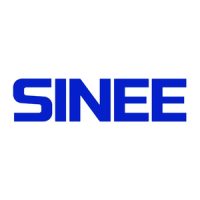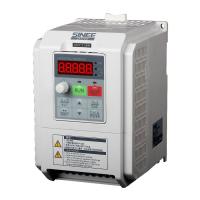
Do you have a question about the Sinee A90-4T5R6B and is the answer not in the manual?
Document number, release time, and version details.
Highlights the main features and capabilities of the A90 series inverter.
Instructions on manual usage, motor connection, and parameter setup.
Definitions of danger and warning levels for user safety.
Critical safety warnings and actions required before inverter installation.
Critical safety warnings and actions required during inverter installation.
Critical safety warnings and actions required during inverter wiring.
Critical safety warnings and actions required before powering on the inverter.
Critical safety warnings and actions required after powering on the inverter.
Critical safety warnings and actions required during inverter operation.
Critical safety warnings and actions required during inverter maintenance.
Specific precautions for motor insulation inspection and thermal protection.
Details on inverter models, voltage, applicable motors, and output currents.
Explanation of different inverter working statuses and running modes.
Procedures for checking the product upon receipt and identifying its model.
Physical dimensions and mounting specifications for inverter installation.
Guidelines for selecting an appropriate installation site and environment.
Instructions on the correct installation orientation and required clearance space.
Standard connection diagram for the inverter and peripheral devices.
Details on the composition and layout of main circuit terminals for wiring.
Description of control circuit terminals, their functions, and wiring diagrams.
Overview of the LED keyboard structure and functions of its keys and indicators.
Explanation of different menu levels and parameter display modes.
Step-by-step flowchart for inverter commissioning and setup.
Checklist of items to confirm before turning on the power supply.
How to check the inverter status after powering it on.
Parameters and methods for controlling the inverter's start and stop functions.
Explanation of how function codes are organized and their general meanings.
Detailed listing of functional parameters, their descriptions, default settings, and attributes.
Detailed explanation of basic function parameters (F00 group) and their settings.
Detailed explanation of motor 1 parameters (F01 group) for accurate motor setup.
Details on configuring the functions of digital and analog input terminals.
Details on configuring the functions of digital and analog output terminals.
Parameters related to controlling the inverter's start and stop operations.
Parameters for Voltage/Frequency (V/F) control mode.
Parameters for Vector Control mode, including speed and torque control.
Parameters for configuring various fault and protection functions.
Parameters for multi-segment speed control and simple PLC functions.
Parameters for configuring the Proportional-Integral-Derivative (PID) control function.
Parameters for configuring communication settings, including Modbus RTU.
Allows users to select and group frequently used parameters for quick access.
Parameters related to keyboard functions, display modes, and parameter locking.
Parameters for configuring torque control modes and limits.
Parameters for configuring a second motor, allowing independent settings.
Parameters for auxiliary functions like jog operation and acceleration/deceleration time settings.
Parameters for configuring virtual input and output terminals for flexible control.
Parameters used for monitoring inverter status, frequency, current, voltage, etc.
Parameters for viewing historical fault types, output status, and working time during faults.
Explanation of the self-identification function for optimizing motor control.
Safety and procedural precautions to take before performing motor self-identification.
Step-by-step guide on how to perform motor parameter self-identification.
Table listing fault codes, causes, and corresponding solutions for inverter errors.
Analysis of common failures and troubleshooting steps for parameter settings and motor rotation.
Routine inspection and cleaning procedures for maintaining inverter performance and longevity.
Information regarding warranty services and conditions for inverter repair.
Details on selecting and calculating the appropriate braking resistor for energy dissipation.
Information on compatible braking unit models and their specifications.
Guidelines for selecting appropriate connecting wires for braking units and resistors.
Defines the series and network types supported by the MODBUS communication protocol.
Describes the RS-485 communication mode, network address, data format, and baud rate.
Details the structure of MODBUS RTU messages, including frame format, address codes, and function codes.
Explanation of communication timeout definitions and intervals.
Provides examples of MODBUS communication requests and responses for common operations.












